Fact:
On May 8, 2019, Taliban insurgents detonated an explosive-laden vehicle and then broke into American NGO Counterpart International’s offices in Kabul. At least seven people were killed and 24 were injured.
Following is the March 2021 installment of “ISIS Redux: The Central Syria Insurgency,” a monthly chronicle of attacks by the terrorist group ISIS in central Syria. Previous editions of ISIS Redux can be viewed through the following links: February, January, December, November, October, September, August, July, June, May, and April. A full background and analysis of ISIS’s resurgence in Syria, including its methodology, can be explored here, here and here.
ISIS militants carried out at least 38 confirmed attacks in March, killing at least 17 pro-Assad regime fighters and 42 civilians, while wounding at least 27 in the Homs, Deir Ez Zor, Raqqa, Hama, and Aleppo governorates. ISIS attacks increased significantly. March had the second most attacks and high quality* attacks since the start of the insurgency. While February’s decline in ISIS activity matched the pattern of the previous two years, this month’s surge came almost one month earlier than it did in 2020.
ISIS attacks during the first half of the month generally followed the trend set last month: Heavy reliance on mines and Improvised Explosive Devices (IED) and many indiscriminate attacks against local civilians. A marked shift in target and attack types occurred on March 21 when, after a three-day lull, five attacks were reported across Homs, Deir Ez Zor, and Hama. Eighteen of March’s 38 attacks occurred in the final 10 days of the month. Only 22 percent of these attacks targeted civilians, compared to 40 percent of the attacks in the first 21 days of the month, and only 38 percent of attacks used mines or IEDs, compared to 52 percent earlier in the month.
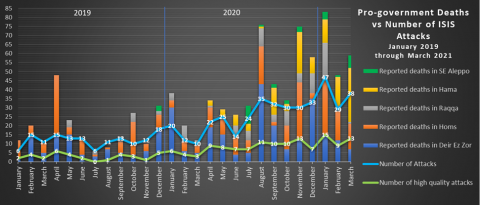
Attacks in March increased in every governorate compared to February, though ISIS again prioritized Hama (16) followed by Homs (10) and then Deir Ez Zor (7). March was the second month in a row that ISIS set a record for attacks in Hama, though the terror group carried out two-thirds of these attacks in the first half of the month. Confirmed attacks also increased in Raqqa (3) and Aleppo (2), despite continued problems accessing credible information in these regions. High quality attacks also grew in every province except Deir Ez Zor.
In Aleppo, ISIS activity returned to the southern Khanasir area, where militants executed four shepherds on March 1 and killed three civilians with a mine on March 17. Raqqa witnessed two important attacks. The first took place on March 25 when militants shelled a regime Air Force Intelligence checkpoint near Resafa, while the second came on March 31 when militants likely affiliated with ISIS set up a fake checkpoint near Dibsi Afnan on the Aleppo-Raqqa border. This was only the second confirmed attack in this region since the start of the insurgency and hints at a possible strengthening of ISIS’s presence here.
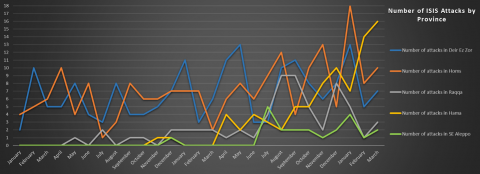
Hama
ISIS activity continued to increase in eastern Hama during March. Unlike February’s entirely passive attacks (mines and IEDs), ISIS cells conducted at least four attacks using small and medium arms in March. Three of these attacks targeted Syrian regime positions, with militants overrunning military outposts on two occasions (March 4 and March 21).
ISIS attacks targeting civilians also increased in east Hama in March. ISIS carried out seven attacks, including one small arms attack that killed 26 and wounded 14 locals. As in February, most of these mine attacks occurred in the Wadi Azeeb area, where in January ISIS ambushed a convoy of civilian vehicles. It is highly likely that ISIS cells have continued to plant mines in this area since that January attack.
ISIS mine attacks continued in the Rahjan area for the sixth month in a row, and militants appear to have upped their attacks on the Ithriyah-Sukhnah road as well, wounding two commanders from the Syrian loyalist militia Liwa al-Baqir on March 12 and killing a Local Defense Forces militiaman on March 22. As in previous months, low scale activity also occurred in southeast Hama, around the strategic town of Uqayribat, where one regime soldier was killed by a mine on March 7. There were an additional four attacks in the “eastern Salamiyah countryside” in March that could not be more specifically located.
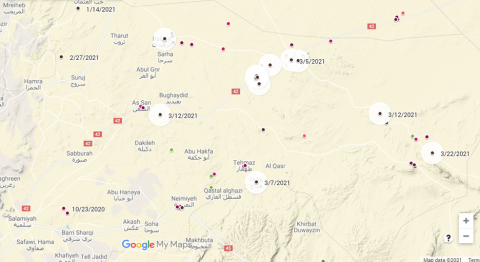
Map of ISIS attacks in Hama in March 2021 (highlighted dots). Not mapped are four additional attacks that occurred somewhere east of Salamiyah.
Homs
There were no recorded ISIS attacks in Homs province during the last two weeks of February and only three minor attacks in the first 18 days of March. This lull ended quickly on March 21, when the group conducted three high quality attacks. ISIS activity continued through the last 10 days of the month, during which four more attacks were carried out.
Five attacks stand out in particular this month, and point to a reinvigorated ISIS presence across the entire eastern half of the province. On March 21, ISIS militants on motorcycles ambushed a group of civilians south of the Shaer Gas Field, killing six. This was the first attack in this area since June 2020. The only confirmed prior attacks occurred in 2018.
On the same day, ISIS militants captured and executed two regime soldiers near Sukhnah and one soldier near Qaryatayn, releasing pictures of the executions within days of the attacks. The Qaryatayn incident, the second attack there in as many months, is significant in that it marks an increased pace of confirmed attacks near the town, only 17 miles from the Damascus border. It was also the first attack ISIS officially claimed there in years (the previous attacks on October 2020 and February 2021 went unclaimed). The fact that ISIS managed to capture a soldier alive and quickly send pictures of the execution to its central media network indicates a strengthening of the militants’ position in this vulnerable area. It is possible that the group is preparing to target Qaryatayn during their likely offensive during Ramadan, which begins on April 13.
The capture of two soldiers near Sukhnah also appears to mark a return of activity around the town. In one the group’s most impressive strings of attacks in recent months, a small ISIS cell of eight to 10 fighters ambushed a bus using small arms fire as it brought new 4th Division reinforcements to the town on March 22. The attack occurred at night on the same day the regime’s 4th Division began moving significant numbers of new fighters and armored vehicles to Sukhnah and Deir Ez Zor. The following day, militants in Deir Ez Zor attacked other 4th Division soldiers as they were taking command of several checkpoints near Shoula.
ISIS further claimed to have destroyed a Syrian Arab Army (SAA) ammunitions truck near Sukhnah and an SAA transport truck north of the town on March 26. These attacks indicate a high degree of intelligence gathering and suggest that the lull in ISIS attacks here during the previous several weeks was not due to a loss in operational capacity.
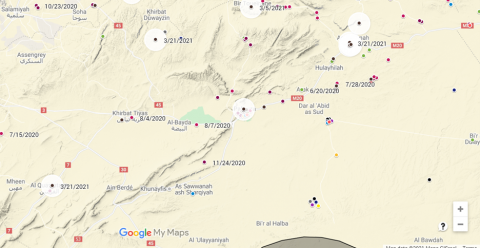
Map of ISIS attacks in Homs in March 2021 (highlighted dots). Not mapped are three additional attacks that occurred somewhere in “eastern Homs.”
Deir Ez Zor
February’s drop in confirmed ISIS attacks in Deir Ez Zor was largely the result of sustained, widespread regime security operations in the northwest corner of the province. Those operations continued until approximately March 10. In the final days of the operations, SAA units moved into the western and eastern sides of Jabal Bishri, discovering multiple ISIS weapons caches and hideouts and destroying several motorcycles and trucks belonging to the militants. Only one confirmed ISIS attack occurred in Deir Ez Zor during the first two weeks of March. Thus, the operation should be viewed as a success for the Syrian regime. It marked the first time a multi-month campaign consisting of SAA, Iranian, and Russian-backed forces, accompanied by air power, has been carried out since the insurgency began.
However, within days of the operation’s conclusion, ISIS renewed its attacks. On March 15, ISIS fighters ambushed a group of civilians on the eastern side of Jabal Bishri, ostensibly cleared just days before, killing one person and destroying two trucks. At least two Islamic Revolutionary Guard Corps (IRGC) fighters, including a field commander, were killed by a mine near Mayadin the following day and a militia checkpoint in the same area was attacked on March 21.
As previously mentioned, ISIS militants killed at least one soldier during their attack on newly manned 4th Division checkpoints near Shoula—again, the main site of the previous months’ clearing operations. Finally, ISIS captured an 11th Division soldier during a patrol in the Faydat Ibn Muwayniah region, southwest of Mayadin. This attack occurred amid several days of opposition outlets claiming multiple attacks against regime forces in this region.
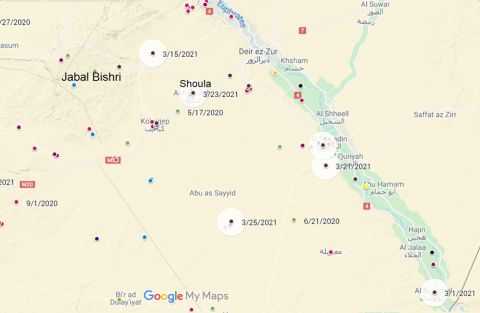
Map of ISIS attacks in Deir Ez Zor in March 2021 (highlighted dots). Not mapped is one additional attack that occurred in an unspecified location in the province.
Regime Operations
As in February, the Syrian regime and its allies continued to conduct extensive anti-ISIS operations in March. However, unlike last month, many of these operations appear to have ended during the middle of the month, providing an opening for the observed surge in ISIS attacks.
As stated previously, the Shoula-Jabal Bishri operation initiated in January continued until about March 10 and resulted in several captured caches and hideouts. Throughout the month Liwa al-Quds fighters also conducted operations in southern Deir Ez Zor and along the Syria-Iraq border. On March 23, Air Force Intelligence soldiers were filmed at a small ISIS hideout they had reportedly discovered in the cliffs overlooking the town of Dweir, Deir Ez Zor. In Homs, Liwa al-Quds and the Russian Wagner forces conducted a 10-day operation south of Tuwaynan, close to where ISIS killed 12 militiamen in February. On March 11, approximately 150 SAA soldiers gathered near Rahjan, Hama for several days of demining operations, though mines continued to kill people in this area afterwards.
Most importantly, fresh regime soldiers, along with tanks and armored vehicles belonging to the 4th Division, arrived in Sukhnah and Deir Ez Zor in the final week of March. These units have yet to conduct any major operations and so far, appear to simply be reinforcing strategic points. The multiple attacks already carried out against these reinforcements raises questions about how effective they will be at countering the insurgency, especially considering the division’s lack of experience in desert combat.
Where ISIS Goes From Here
The first quarter of 2021 had almost three times the confirmed number of ISIS attacks (112), high quality attacks (37), and deaths (189) compared with the first quarter of 2020 (42, 13, and 70) and four times as many (32, 8, and 43) as in the first quarter of 2019. March broke the pattern set in the past two years, with the group returning to its high rate of attacks in both core and exterior regions nearly a month earlier than usual. This resumption of activity in what is historically an off month does not bode well for the region during the expected Ramadan offensive that is a hallmark of the terrorist group.
Yet this expansion and strengthening of the insurgency does not mean that regime-held towns or economic facilities are on the cusp of falling. To assume such is to deeply misunderstand the role the Badia (Syrian desert) plays in the broader ISIS insurgency across northeast Syria and Iraq. Central Syria is ISIS’s safe zone, and its resource bed, so to speak, where new recruits are trained, caches are safely held, smuggling and extortion operations are based, and where insurgents return between fighting in the neighboring regions.
ISIS does not seek to hold territory here beyond its scattered camps deep in the desert and mountains where regime forces do not travel. Thus, the cells can easily move around regime patrols, and ISIS only faces real pressure when regime operations are conducted on multiple fronts for sustained periods of time. ISIS leverages its strength along the important highways to extort from traders and oil men, charging protection fees to allow safe passage. It is possible the group has also struck deals with the Syrian business moguls who operate the oil and gas facilities in the Badia, receiving money or fuel in exchange for leaving the facilities alone, though this is only speculation at the moment.
Capturing towns or these economic centers would significantly harm the insurgency. Sustained urban combat is one of the only guaranteed means for the regime to inflict unsustainable losses on ISIS, and destroying the oil and gas industry in the region would directly harm the group’s ability to raise money.
This is not to say that these areas cannot become targets for the insurgents. As the group grows stronger, it will seek to raid larger bases, hoping to secure more weapons and supplies from regime stockpiles in towns like Uqayribat, Qaryatayn, and Sukhnah. Targeting regime commanders further weakens security in the area and opens more lucrative smuggling and criminal routes for ISIS to raise money. Civilian and military convoys alike will always remain targets as a means for the insurgents to pressure businessmen, harm the regime financially, and attempt to limit regime military movement on the main highways.
For the Badia, a strengthened ISIS means more freedom of movement, more effective intelligence gathering, more robust smuggling and financial opportunities, and the ability to establish cells in the exterior regions of east Hama, south Homs, and southeast Aleppo. Achieving any of these goals allows the group to more easily conduct operations across the border in Iraq and across the Euphrates in northeast Syria, as well as enabling further expansion back into areas near Suwayda, Dara’a, and Damascus.
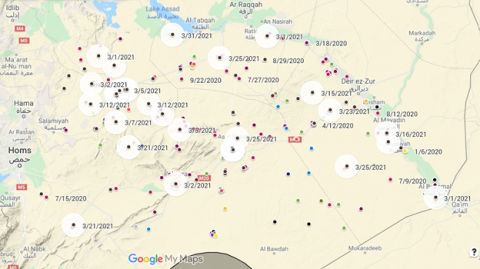
Map of locatable ISIS attacks (highlighted dots) in March 2021. This map does not include seven attacks which did not have specific locations attributed to them: four "east Salamiyah" Hama attacks, two "east Homs" attacks, and one "Deir Ez Zor countryside" attack. To view an interactive version of this map, please click here.
---
*High quality attacks are defined as attacks behind frontlines, those that result in seized positions, target regime officers, involve coordinated attacks on multiple positions, fake checkpoints, ambushes on military convoys, or attacks on checkpoints that kill at least three soldiers or lead to POWs.
Extremists: Their Words. Their Actions.
Fact:
On May 8, 2019, Taliban insurgents detonated an explosive-laden vehicle and then broke into American NGO Counterpart International’s offices in Kabul. At least seven people were killed and 24 were injured.
Get the latest news on extremism and counter-extremism delivered to your inbox.